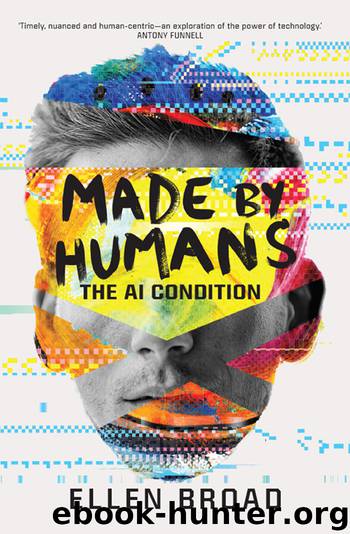Made by Humans: The AI Condition by Ellen Broad

Author:Ellen Broad [Broad, Ellen]
Language: eng
Format: epub
ISBN: 9780522873313
Google: yeuOswEACAAJ
Publisher: Melbourne University Publishing
Published: 2018-07-30T01:05:43.775000+00:00
8
Openness
These days, building ‘accurate’ AI decision-making systems is more a marketing feature than an indicator of quality. Organisations promoting their highly effective, accurate algorithms don’t have a responsibility to prove how their system is accurate, and what accuracy means. They could be terrible. They could be brilliant. But they’re basically black boxes. Not necessarily because they’re too complicated to be understood, but because there’s no real pressure on organisations to be transparent about the way their systems work. It reminds me of the state of the pharmaceuticals sector barely a century ago.
The Lydia Pinkham pharmaceuticals brand was ubiquitous at the turn of the twentieth century. ‘I took Lydia E Pinkham’s Vegetable Compound because I was tired and rundown. I’m stronger and feel fine now, and am able to do my own housework,’ testified one Mrs JC Greaves in an advertisement for the tonic in Sydney newspaper The World’s News in 1925.1 Around the world, Lydia Pinkham was a trusted over-the-counter remedy. There were other popular, readily available drugs as well, such as Warner’s Safe Cure, another vegetable concoction believed to help cure diabetes, asthma and constipation; Zam-Buk, a balm for treating cuts, bruises, freckles, colds and toothaches that mainly consisted of paraffin wax; and California Syrup of Figs, a remedy for babies with constipation, wind, colic or diarrhoea. These were all examples of ‘patent medicines’—drugs developed by proprietary companies and heavily marketed to the general public, often with exaggerated claims about their effectiveness and little to no information about their ingredients or side effects.
The medical profession loathed patent medicines. Patent medicines, fortunately, weren’t the only kind of drugs available. ‘Ethical’ drugs, as labelled by the American Medical Association (AMA), were developed in accordance with the AMA’s Code of Ethics, listed in the United States Pharmacopoeia and only marketed to medical professionals. The AMA Code of Ethics argued that ‘physicians could not in good conscience prescribe or recommend a medicine whose contents were unknown and whose safety and effectiveness could not be subjected to the scrutiny of the scientific community.’2 But the Code of Ethics was voluntary, and because people could self-medicate using over-the-counter drugs rather than see a medical professional, most patent medicine manufacturers ignored it.
From the turn of the twentieth century, though, the medical profession, journalists and policymakers started investigating the claims made by patent medicine makers, and their mysterious ingredients. A British Medical Journal report in 1908 estimated that the cost of ingredients for a jar of Zam-Buk was so low that its retail price reflected a markup of 5200 per cent. In other words, 98 per cent of the sticker price was pure profit.3 In 1905, Samuel Hopkins Adams’ exposé of the patent medicines industry, titled ‘The Great American Fraud’, exposed high quantities of alcohol in Lydia Pinkham’s Vegetable Compound.4 The AMA later noted that the California Syrup of Figs, the laxative tonic for babies, was about 6 per cent alcohol, roughly the same as full-strength beer. The public was being hoodwinked by dubious alcoholic cocktails with little to no scientific merit.
Download
This site does not store any files on its server. We only index and link to content provided by other sites. Please contact the content providers to delete copyright contents if any and email us, we'll remove relevant links or contents immediately.
| Computer Vision & Pattern Recognition | Expert Systems |
| Intelligence & Semantics | Machine Theory |
| Natural Language Processing | Neural Networks |
Algorithms of the Intelligent Web by Haralambos Marmanis;Dmitry Babenko(16232)
Jquery UI in Action : Master the concepts Of Jquery UI: A Step By Step Approach by ANMOL GOYAL(9385)
Test-Driven Development with Java by Alan Mellor(7729)
Data Augmentation with Python by Duc Haba(7605)
Principles of Data Fabric by Sonia Mezzetta(7375)
Learn Blender Simulations the Right Way by Stephen Pearson(7293)
Microservices with Spring Boot 3 and Spring Cloud by Magnus Larsson(7137)
Hadoop in Practice by Alex Holmes(6586)
RPA Solution Architect's Handbook by Sachin Sahgal(6513)
The Infinite Retina by Robert Scoble Irena Cronin(6215)
Big Data Analysis with Python by Ivan Marin(5930)
Life 3.0: Being Human in the Age of Artificial Intelligence by Tegmark Max(5506)
Pretrain Vision and Large Language Models in Python by Emily Webber(4893)
Infrastructure as Code for Beginners by Russ McKendrick(4651)
Functional Programming in JavaScript by Mantyla Dan(4432)
WordPress Plugin Development Cookbook by Yannick Lefebvre(4379)
The Age of Surveillance Capitalism by Shoshana Zuboff(4241)
Embracing Microservices Design by Ovais Mehboob Ahmed Khan Nabil Siddiqui and Timothy Oleson(4146)
Applied Machine Learning for Healthcare and Life Sciences Using AWS by Ujjwal Ratan(4132)
